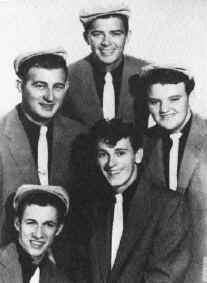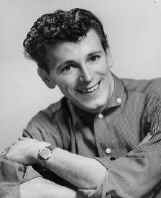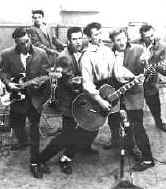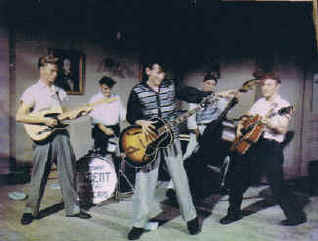Gene Vincent and his
Blue Caps

Clockwise from the top
Jack Neal, Dickie Harrell,
Gene Vincent, Willie Williams, Cliff Gallup
One of the most engaging, if tragic, figures in rock and roll
history, Gene Vincent personified the wild, lusty, lower class
side of the music as a touring artist. Scoring one of the
earliest smash rockabilly hits with the classic "Be
Bop-a-Lula" in 1956, Vincent recorded some of the most
exciting libidinous rockabilly of the era propelled by the
outstanding lead guitar work of Cliff Gallup.
Members:
Gene Vincent - guitar, vocals
The Blue Caps:
Cliff Gallup - lead guitar
Paul Peek - rhythm guitar
Willie Williams
Jack Neal - upright bass
Dickie Harrell - drums
Clifton Simmons piano

Vincent Eugene Craddock was born in 1935 in
Norfolk, Virginia. His family moved to Muden Point,
Virginia when he was seven. Vincent began playing the guitar at
an early age. Hearing the Grand Ole Opry on the radio and gospel
music of the local black churches; he played with neighborhood
black musicians on the porch of his parents' country store. After
six years the Vicents moved back to Norfolk, and in 1952 at the
age of 17 and in the ninth grade, his father signed papers
allowing him to join the U.S.Navy.

gif courtesy RAB Hall of Fame
In May, 1955, after signing up for another six
years, Vincent was in a motorcycle accident that shattered his
left shinbone. The injury would never heal properly and he spent
the rest of the year in a brace. While in Veteran's Hospital in
Portsmouth, Virginia Vincent wiled away the hours playing the
guitar. It was here that he paid a patient, Don Graves, twenty
five dollars for a song he had written "Be-Bop-A-Lula"
that was about a local stripper.

Gene Craddock - 1955
Photo courtesy Pat Mason
Back in Norfolk, Gene Vincent as he now called himself tried
to catch on as a country singer. Spending his spare time at WCMS,
the local country radio station, he auditioned for "Country
Showtime" the station's live show hosted by
"Sheriff" Tex Davis. Billed as Gene Craddock and the
Virginians, Vincent became a local recording star singing in live
shows and radio. Davis became his manager and bought co-author's
rights to Be-Bop-A-Lula" for twenty five dollars. Seeing the
popularity of Elvis at the time Davis and his partners formed the
Blue Caps around Vincent and sent a demo to Ken Davis Capitol's
A&R man. In April, 1956 a recording contract was signed with
Capitol Records.
The first session was held in Nashville with Jack Neal on
bass, Willie Williams and Cliff Gallup on guitar, and Dickie
Harrell on drums. Four songs
"Be-Bop-A-Lula," "Race With The Devil,"
"Woman Love" and "I Sure Miss You" came out
of the session. The first single was credited to Gene Vincent and
His Blue Caps. Blue Caps was in reference to President
Eisenhower's baby blue golf cap. The A side was "Woman
Love" and "Be-Bop-A-Lula" on the B side. Critics
complained about the suggestive lyrics and impassioned delivery,
so disc jockeys began playing the B side.
"Be-Bop-A-Lula" became an instant hit.

The second release "Race With The Devil" was
immediately rejected by the radio stations and replaced by
"Blue Jean Bop".
Touring caused Vincent's injured leg to act up just as he was
to film a cameo for the movie "The Girl Can't Help It".
Vincent was able to sing in the movie "Woman Love"
after the wardrobe department hid the cast under his jeans and
painted the toe of the cast to resemble a shoe.
In December, 1956 Vincent was booked for a month at the Sands
Hotel in Las Vegas. A week of pain in his leg forced him to
cancel the remainder of the shows. He reentered the Veterans
Hospital in Portsmouth for treatment

1957 Blue Caps
Clockwise from top: Gene Vincent, Johnny Meeks, Bill Mack, Paul
Peek, Tommy Facenda and Dickie Harrell
In 1957 he was fitted with a metal brace that he would wear
for the rest of his life. He began touring again. There were
numerous changes in the band with an electric bass and two
singers called the Clapper Boys doing a dance routine.

Picture from the movie The Girl Can't Help It
In 1957 he released "Dance To The Bop," appeared on
"American Bandstand" and "Big D Jamboree" in
Dallas which led to a tour of Australia with Little Richard and
Eddie Cochran, with whom he became good friends. Cochran
would sing back-up on Vincent's "Record Date"
album.
In November, 1957 Vincent appeared on "The Ed
Sullivan Show". Stories of strange behavior on and off
stage began circulating in the spring of 1958. It seemed he was
drinking heavily to keep his energy up and taking two bottles of
aspirin for his assorted aches and pains.

In 1958 Vincent lost his home in Dallas to back
taxes. Later he moved to Los Angeles where he only found low
paying jobs. Three weeks of not being paid caused the Blue
Caps quit.
In 1959 he began playing the Pacific Northwest with pickup
bands. This led to a tour of Japan. The tour was successful but,
he became paranoid and went back to Los Angeles.
In December he went to England where he was met as a hero. An
appearance on Jack Good's "Boy Meets Girl" a British
television rock and roll show led to a permanent spot on the
show. Good is credited with creating the all black leather image
that became Vincent's trademark.

Vincent convinced his friend Eddie Cochran to come over
and on his arrival they began a 12 week tour. While riding
in a taxi in Chippenham, Wiltshire on April 17, 1960 with Cochran
and Cochran's girlfriend, Sharon Sheeley, there was an accident
that tragically ended Cochran's life, and severely injured
Vincent's leg -- that would leave him with a limp for the rest of
his life.
In 1961 he toured South Africa. Later, he performed in
Liverpool with the Beatles as an opening act. The next four
years were spent in England performing when asked and making
records that didn't sell. His Capitol Records contract expired in
1963.
In 1966 he signed with Challenge records. In 1969 he
played the Toronto Peace festival but, was lost among John
Lennon, Doors, Chuck Berry and Jerry Lee Lewis. He returned
to England until returning to America in failing health in
1971. An attempt to land a new recording deal failed.
After a string of unsuccessful appearances at the San
Francisco Park Festival he returned to his home to Los Angeles. .
Soon there after, he was admitted to the Inter-Valley
Hospital in New Hall, California with a bleeding stomach ulcer.
On October 12, 1971 he died at the age of thirty six.
In 1992 a British promoter contacted Johnny Meeks in
California about a Blue Caps reunion tour. Meeks contacted
Clapper Boy Tommy Facenda and for a month in the summer of 1993
the 1958 line-up of Blue Caps played sold out shows in France,
England, and Germany.
In 1993 Jeff Beck, with the Big Town Playboys, released Crazy
Legs, an album of of just songs done as a tribute to him and
his guitarists.
Gene Vincent was elected to the Rock and
Roll Hall of Fame in 1998.
The Blue Caps were elected to the Rock and Roll
Hall of Fame in 2112
Cliff Gallup died October 9, 1988, he was 58.
Paul Peek died April 3, 2001, he was 63.









